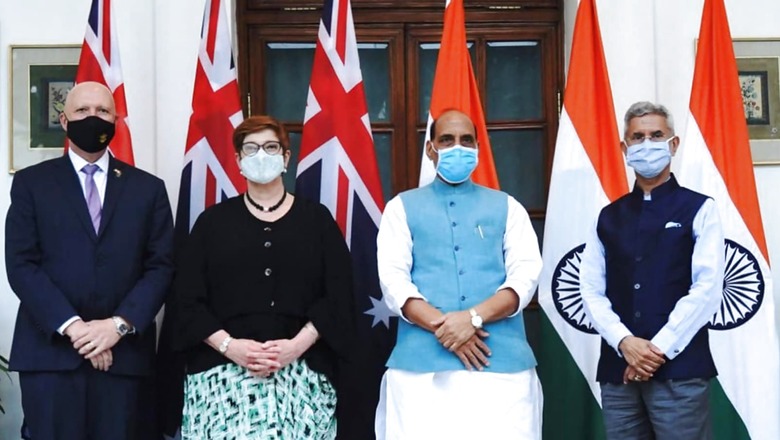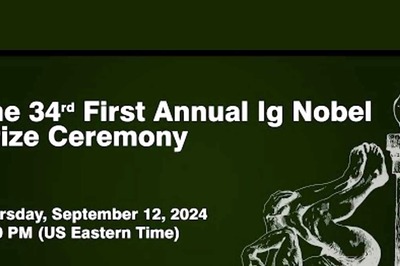
views
It was remarkable that on the same day we remembered the horror of 9/11, India and Australia were holding the inaugural 2+2 meeting of defence and foreign ministers, finding their place in a new, fragmented and multi-polar world.
With this and other regional meetings, Australia is taking tentative steps into the multi-polar world after over 70 years holding fast to one key relationship – the USA alliance. India, on the other hand, always comfortable with a multi-polar view, is taking new steps closer to the USA and edging away from a non-aligned world view. In the Indian way of diplomacy, India also recently held a 2+2 with Russia, demonstrating its capacity to build relationships across diversity.
The focus of the talks at the two-plus-two dialogue is expected to be on boosting overall cooperation in the Indo-Pacific in the face of China’s growing military assertiveness in the region. Both Australia and India are part of the Quad or Quadrilateral coalition that resolved to work towards ensuring a free, open and inclusive Indo-Pacific. The other two members of the Quad are the US and Japan.
Australia can help India understand the downside of clinging too close to America – it has the experience of fighting alongside America in a stream of battles aiming to rebuild other nations to become democracies – as if imposing democracy from outside was ever going to work.
For India, closeness to America will be a challenge on many fronts. It will not like America’s preoccupation with revenge. Consider President Joe Biden speaking after US troops were bombed exiting Afghanistan – “We will not forget. We will not forgive. We will hunt you down.” In these circumstances India and Australia would be looking for justice but not vengeance.
Another level of discomfort for India will be the “evangelical democracy” which dominates America’s world view – it sees itself on a mission to reshape “failed” countries in its own image, building democracy whether they want it or not. The “democracy” message used to hold the promise of prosperity, until China showed that you do not need to be a democracy to become wealthy and powerful.
China is changing how India and Australia see their place in the world. Now, can India and Australia help America change too? Can we shift America towards acceptance of difference between countries, away from trying to change the world and rebuild it in their own image?
As middle powers in a divided world, both countries can be more influential than ever before, if they choose to be. It would aid global peace if they could help America learn to live with the power of China. Even more, help America accept difference between nations and the reality that not everyone wants to become a democracy.
The India and Australia defence and strategic meeting came soon after both countries agreed to reinvigorate the free trade talks – the Closer Economic Cooperation Agreement, hoping for some completion of “early harvest” deals by the end of this year. Priority areas will be critical minerals, infrastructure, energy, technology, agribusiness, education and space.
Trade and investment need a basis of security, stability and even strong defence links in order to thrive, so this 2+2 meeting sends a positive signal to money and business.
How quickly things change for those of us in trade and investment. China has been a perfect lesson in how trade and investment can be so vulnerable to shifts in diplomacy and geopolitics. It was only in 2015 when the Australian Government celebrated a Free Trade Agreement with China which signalled a “new era of opportunity for Australia”. How naïve this description sounds today after the punitive trade actions of China.
India is of course proud to be the world’s largest democracy. But in the 75 years of democratic history, India can rightly claim to be the world’s most resilient democracy, based on one key measure – it is built on extraordinary challenges of diversity. With over 29 major languages, diverse cultures and beliefs, vast ranging levels of education and only recently building a middle class, that India has maintained the strength of democracy is in itself a miracle and a signal to the world that you can indeed find strength in diversity.
Former Australian Prime Minister Tony Abbot recently said: “The answer to almost every question about China is India.” He pointed out that India is perfectly placed to substitute for China in global supply chains, it has revived the Quadrilateral Security Dialogue, and the first in-person Quad summit is expected before the end of the year.
Naval ties have become stronger under Indian PM Narendra Modi — India has invited Australia to join the annual Malabar naval exercises that will soon involve India, the US, Japan, Australia and also the UK.
Abbott concluded: “If Australian business and officialdom were to make the same effort with India that they’ve long made with China, there’s potential for a ‘family’ relationship with India that was never likely with China.”
As they become closer, can India and Australia help the USA to move on from a state of trying to fix the world? Can they help America see the world through a broader lens than the narrow one of democracy? Can they help America see that spreading democracy with violence is futile and costly?
Or will America become a difficult partner, hoping to change the world by force and with God on their side?
David Morris served as an Australian diplomat for a decade, analysed security challenges from Southeast Asia to the Balkans and was a major contributor to highly-respected reform proposals for the United Nations and peacekeeping. He recently said our biggest tribute to the people who lost their lives in the 9/11 attack would be to apply our best thinking to building peace and turning away from almost constant and senseless wars.
In a multi-polar world, the strategy of violence comes with increased risk and peace is the only alternative worth striving for – this should become the new aim of middle powers such as India and Australia.
(The views expressed in this article are those of the author and do not represent the stand of this publication.)
Read all minute-by-minute news updates for Uttar Pradesh election results 2022, Punjab election results 2022, Uttarakhand election results 2022, Manipur election results 2022, and Goa election results 2022.
Click here for seat-wise LIVE result updates.

















Comments
0 comment